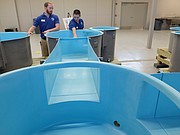Chattanooga's 24-year-old Tennessee Aquarium is a visual feast of otters which play, fish that dart, alligators that glide and butterflies which flutter.
Writ larger, it's also a freshwater habitat of the diversity of creatures that can be found in the lakes and streams of the Southeast United States and an education on why what's found there is there.
The two buildings that comprise the aquarium, on their own, have been the one tourist attraction that has sparked the economic renaissance of a city that often was counted out 30 years ago.
And now a new building joins the aquarium fold, one born of the need to sustain in Chattanooga, in the Southeast and perhaps across the country and world the habitat that supplies all that can be glimpsed, heard and touched in the galleries of the aquarium.
While the nonprofit Tennessee Aquarium Conservation Institute (TNACI) has been in existence nearly as long as the aquarium itself, its new headquarters on the bank of the Tennessee River celebrated a grand opening Thursday on the campus of Baylor School.
The 14,000-square-foot facility was built to allow a more centralized place to conduct scientific studies, learn how to better restore the region's natural ecosystems and educate members of the public on how they can help.
Simply put, it will help the Tennessee Aquarium practice what it preaches about fresh water biodiversity.
The space itself will expand the aquarium's ability to educate high school students, teachers, conservation professionals, ecotourism guides and Aquarium members.
And the timing, with Thursday's announcement of the state's improvement in science test scores on the 2015 National Assessment of Educational Progress, couldn't be more perfect.
What better way, after all, to sustain such scores - the state's eighth-graders were the fastest improving in the nation and its fourth-graders the second fastest - than witnessing at TNACI and perhaps participating in activities dealing with one branch of science.
(The state's fourth- and eighth-grade students, with their improvement in science, now rank 19th and 21st, respectively, in the country, their highest-ever mark on what's known as the Nation's Report Card.)
The work at the institute is enough to make those whose eyes glaze over at the first mention of biology sit up and take notice.
- It will, for instance, continue raising endangered species like mussels, lake sturgeon and Appalachian brook trout in its Propagation Room and returning them to their native habitats. But it also will create artificial streams, where the effects of man and temperature on various species can be measured.
- Its Geographic Information Systems Lab continues to allow information collected in the field or in museums to be precisely mapped, giving researchers the most precise information about what freshwater aquatic animals are where. Indeed, the lab just completed a map with 600,000 data points of the biodiversity of the Southeast.
- Its genetic lab continues to determine - with a tiny fin clip or toenail clip - what all lives in that Southeast biodiversity and the differences in its various populations and species.
- Its ecology and morphology lab continues to study why the animals live in the rivers and streams, how where they live within the system may alter them (turtle shell heights, for instance, can depend on river flow) and what previously undetected species might be there.
One of the most fascinating aspects of the institute is its stewardship of natural resources. Water from the roof - if it ever rains again - will flow into a 6,000-gallon cistern. The water from that cistern will be used to flush toilets and irrigate the landscape around the building. Overflow from the cistern first enters an area of native aquatic plants, then makes its way around the building and through constructed wetlands to an enlarged natural wetland and then to the river. As its does, impurities are naturally filtered out so pure water enters the Tennessee.
Further, the road to the site is not paved, a culvert that had to be crossed was converted to a bridge to allow more natural fish passage, hyper-local plants surround the building and a small solar panel array provides any hot water needed in the building.
The view from the building's conference room - a sweeping look down the river as it passes between Elder and Signal mountains - reminds anyone present why the institute does what its does. Not to dramatize its importance, but without its presence, fewer species would be identified, less of the habitat would be sustained and fewer people would be knowledgeable about the importance of protecting the beauty that surrounds them.
